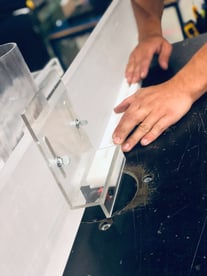Worker safety is a vital issue that concerns us all, as no one is safe from occupational accidents. Obviously, certain fields of employment are considered more at risk. This is especially true of industrial settings where workers are required to spend long hours in a noisy environment. Yet, workplace injuries can indeed be prevented. This article will present three key elements to consider in order to reduce accident risks.
1. Structures
Worker safety must be a priority for all industries, especially those with structures and catwalks often used by workers. For example, employees can be at risk of falling from a ladder or other various types of structures. As a matter of fact, falls are a common cause of workplace injuries. According to the CNESST’s annual report, 9,951 of the 16,200 falls recorded in 2018 were same-level falls.[1] Also according to the latest CNESST report, 12,350 of the 91,711 declared accidents were caused by structures and surfaces. These accidents could probably have been avoided thanks to skid-proof surfaces that minimize the risk of falls for workers.
Metals have extremely limited anti-slip properties. In fact, metals such as steel are not skid-proof unless they have been specially cast. This is where fibreglass reinforced plastic (FRP) comes into play. Slip-resistant FRP gratings are an effective solution to reduce slips and falls. Compared to structures made from traditional materials such as steel, FRP structures have many advantages:
Electrical insulation properties: FRP is nonconductive by design, which is why it is sometimes used to build electrically isolated platforms (EIPs). FRP is also transparent to magnetic fields, making it ideal for use in aluminum smelters or power plants.
Excellent fire-retardant properties: it is highly resistant to heat and flames.
Excellent weight/mechanical strength ratio: FRP structures are both light and extremely resistant (70% lighter than steel)
Easy to maintain: FRP gratings are easy to clean and, since they are not painted, will never lose their pigmentation. The natural colour of FRP comes from the pigmentation of the resin. FRP gratings can also be painted.
2.Machine guarding
Moving parts are often the cause of serious accidents, particularly in industrial settings. Therefore, special attention should be paid to these types of parts. They should imperatively be equipped with protective devices that reduce the risk of accidents by limiting access.
 Polycarbonate is undoubtedly the ideal material for this type of protection, as it is light, transparent and extremely resistant. It is in fact 250 times more impact resistant than standard glass, making it a perfect choice for transparent blade guards on saws, for instance.
Polycarbonate is undoubtedly the ideal material for this type of protection, as it is light, transparent and extremely resistant. It is in fact 250 times more impact resistant than standard glass, making it a perfect choice for transparent blade guards on saws, for instance.
3.The number of decibels
Noise is a potential source of occupational accidents and illnesses in industrial environments such as factories, where decibel levels tend to be high. According to Quebec’s Regulation respecting the quality of the work environment, the maximum permitted exposure levels for an 8-hour shift is 90 dB(A).[1] Although factory employees must be equipped with ear plugs to prevent this long exposure to noise from damaging their hearing. Nevertheless, the most effective way to reduce noise is by dealing with it at the source.
“Reduce the vibration of metal panels by replacing the metal wheels on a container with plastic or rubber wheels, among other things.”[2]
“Controlling the dominating source of noise will have the greatest impact on reducing noise exposure.”[3]
For production lines, choosing sound-absorbing materials is an easy and efficient way to reduce impact noise at the source. The mechanical performance of plastic materials is equivalent and sometimes even superior to certain metals. Additionally, performance plastics not only attenuate impact noise but also reduce the wear and tear of critical parts. One example is ultra high molecular weight polyethylene (UHMW), which is a type of plastic that has excellent noise reduction properties thanks to its high impact strength.
[1] http://www.santeautravail.qc.ca/web/rspsat/dossiers/risques-physiques/bruit/lois (French only). See also: https://www.ccohs.ca/oshanswers/phys_agents/exposure_can.html
[2] http://www.santeautravail.qc.ca/c/document_library/get_file?uuid=aa882545-a1c7-4ca5-8516-64b79222b5c1&groupId=67467 (French only)
[3] Ibid
Advantages of choosing performance plastics:
- Reduces decibel levels
- Reduces accident risks
- Reduces friction and wear
- Reduces contamination risks
- Reduces frequency of maintenance
- Reduces maintenance costs
- Allows for the Self-lubrication of mechanical parts











